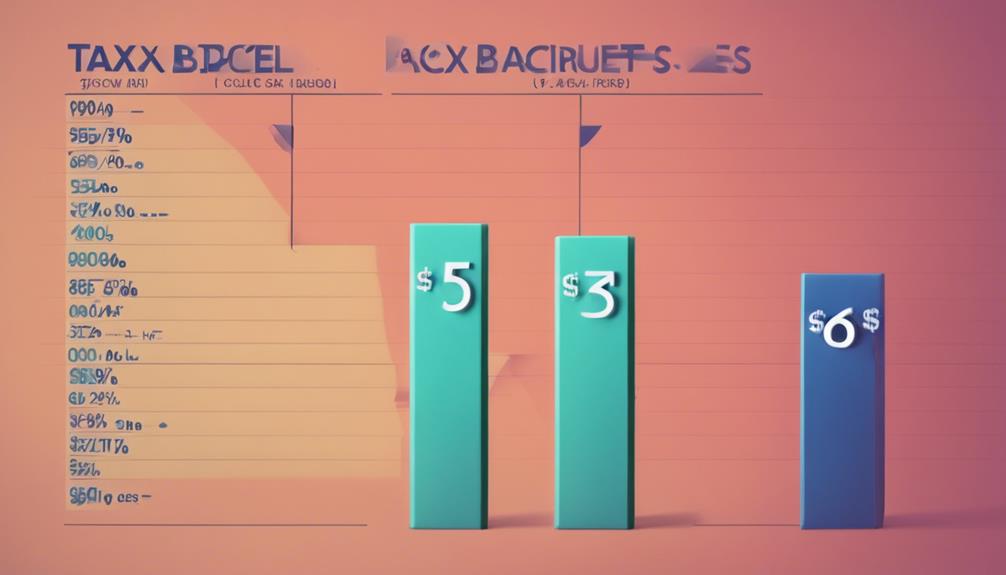Understanding tax brackets is essential to managing your income effectively. Moving into a higher bracket means more of your income is taxed at a higher rate. By knowing your bracket, you can make informed decisions to minimize tax owed. Consider deductions and credits to optimize your tax situation. The 7 U.S. federal brackets range from 10% to 37%. Check how your filing status impacts these brackets. Being aware of tax bracket nuances is crucial for accurate tax planning.
Key Takeaways
- Tax brackets determine income portions taxed at specific rates.
- Knowing your bracket aids in minimizing tax liability.
- Different filing statuses may have separate tax brackets.
- Small income increases can push you into a higher bracket.
- Deductions can lower taxable income, impacting tax bracket placement.
Tax Bracket Basics

To comprehend how tax brackets operate, you must understand that they determine the rate at which specific portions of your income are taxed.
In the U.S. federal income tax system, there are seven tax brackets with rates ranging from 10% to 37%. Your taxable income is divided into these brackets, and each portion is taxed at the corresponding rate.
For instance, if your taxable income falls into the 22% tax bracket, that particular portion of your income will be taxed at a 22% rate.
Understanding tax brackets is vital because they play a significant role in calculating how much of your income is subject to different tax rates. By knowing which bracket your income falls into, you can make informed decisions about earning and reporting income to optimize your tax situation.
It's crucial to grasp these fundamentals to navigate the federal tax system effectively and minimize your tax liability.
Effective Vs. Marginal Rates

When comparing effective and marginal tax rates, you'll see how deductions and credits impact what you owe versus the rate on your last dollar earned. This difference can greatly affect your tax planning strategies, making it crucial to understand how each rate works.
Rates Comparison: Effective Vs. Marginal
Understanding the difference between effective and marginal tax rates is vital for making informed financial decisions regarding your taxes.
Your marginal tax rate refers to the tax rate on the last dollar of your taxable income, while your effective tax rate is the percentage of your income that you owe in taxes after considering deductions, exemptions, and credits.
Marginal tax rates are pivotal in tax planning because they stay constant for specific income levels, helping you anticipate how much tax you'll owe as your income changes. Even a small increase in income can push you into a higher tax bracket, affecting your marginal tax rate.
On the other hand, your effective tax rate may be lower than your marginal tax rate due to the deductions and credits applied to your taxable income.
Understanding these differences can help you optimize your tax strategies and minimize the amount you owe each year.
Impact on Tax Planning
Reflect on the implications of your marginal and effective tax rates on your tax planning strategies.
Your marginal tax rate is essential for understanding how additional income impacts the taxes you pay on that extra dollar earned. On the other hand, your effective tax rate takes into account deductions and credits, providing a more precise reflection of your total tax burden.
By utilizing deductions and credits effectively, you can lower your effective tax rate within your marginal tax bracket.
Understanding how tax brackets influence your marginal and effective rates is vital to making informed financial decisions.
By strategically planning your income and deductions, you can optimize your tax situation. For example, if you're near the threshold of a higher tax bracket, you may want to contemplate deferring income or increasing deductions to stay within a lower bracket.
Being aware of both your marginal and effective tax rates empowers you to minimize your tax liability while maximizing your financial resources.
Understanding Tax Rate Differences
Mastering the distinction between effective and marginal tax rates is essential for optimizing your tax planning strategies. Your marginal tax rate is the rate applied to the last dollar you earn, while your effective tax rate is the percentage of your income owed in taxes after deductions and credits. Understanding these rates is pivotal for making informed financial decisions. Below is a comparison table to help clarify the differences between marginal and effective tax rates:
| Aspect | Marginal Tax Rate |
|---|---|
| Definition | Rate applied to the last dollar earned |
| Consistency | Constant within a specific income level |
| Impact on taxes | Determines the tax on additional income |
| Importance | Guides tax planning strategies |
| Relationship to ER | Does not consider deductions and exemptions |
| Aspect | Effective Tax Rate |
| Definition | Percentage of income owed after deductions |
| Variability | Varies based on deductions and exemptions |
| Impact on taxes | Reflects overall tax burden on total income |
| Importance | Helps in accurate tax planning and decision-making |
| Relationship to MR | Considers deductions and exemptions affecting tax |
Understanding the nuances between these rates empowers you to optimize your tax strategies and reduce your tax liabilities effectively.
Number of Brackets

The U.S. federal income tax system currently comprises seven tax brackets for determining individual tax obligations. These brackets, ranging from 10% to 37%, are applied based on taxable income levels. Understanding how these brackets work is essential in calculating your federal income tax accurately.
Each bracket corresponds to a specific range of income, with increasing tax rates as you move into higher brackets. It's worth mentioning that these brackets are adjusted annually for inflation to keep up with economic changes.
Moreover, different filing statuses, such as single filers or married joint filers, may have separate tax brackets. This means that the number of tax brackets you fall into could vary depending on your filing status.
Impact of Deductions

To optimize your tax savings and better understand how deductions can impact your taxable income, let's explore their significance in relation to the tax brackets you fall into. Deductions play a crucial role in reducing your taxable income, potentially moving you into a lower tax bracket and resulting in significant savings on your tax bill. The impact of deductions becomes more pronounced as you move into higher tax brackets, where they can lead to greater tax savings. Understanding how deductions work is key to maximizing the tax benefits available to you. By strategically claiming deductions, you can effectively reduce the amount of income that is subject to different tax rates based on the bracket you are in. TurboTax provides expert guidance to help you navigate the complexities of deductions and ensure you optimize your tax savings.
| Deductions Impact | Significance |
|---|---|
| Reduces Taxable Income | Lowers tax liabilities |
| Moves to Lower Bracket | Saves money |
| Greater Savings in Higher Brackets | Maximizes tax benefits |
| Essential for Tax Optimization | Strategic planning |
| Expert Guidance Available | TurboTax support |
Pandemic-Driven Migration

You'll see how the pandemic has spurred a significant shift in where people choose to live, with many opting for states with more favorable tax environments like Texas and Florida.
These migration patterns are driving states to reevaluate their tax policies to remain attractive to individuals and businesses.
Monitoring these trends is essential for states to stay competitive in attracting residents and investments.
Migration Trends Analysis
Amid the ongoing pandemic, significant shifts in population movement towards low-tax states have been observed, sparking a trend of pandemic-driven migration. Individuals are choosing to relocate for reasons such as tax benefits and lifestyle changes, leading to a reevaluation of tax policies in various states. States must closely monitor migration trends to adapt their tax policies and maintain economic competitiveness.
Understanding these migration patterns provides valuable insights into how tax policies influence population movements. Data on pandemic-driven migration underscores the importance of considering tax implications when making relocation decisions. By analyzing these trends, policymakers can better understand the impact of tax brackets and income taxes on people's decisions to move, ultimately shaping the future landscape of population distribution within the United States.
It's essential for states to stay informed about migration patterns and adjust their tax policies accordingly to attract and retain residents.
Tax Policy Adaptation
With pandemic-driven migration influencing population shifts towards low-tax states, states are adapting their tax policies to attract and retain residents seeking financial benefits. As individuals increasingly opt for locations with favorable tax policies, state governments are recalibrating their tax brackets and incentives to align with the shifting migration trends. The flexibility provided by remote work options has further spurred this movement towards states offering advantageous tax structures.
By closely monitoring migration patterns, states can better understand the impact on their tax revenues and overall economic competitiveness. This data-driven approach enables states to tailor their tax policies effectively, ensuring they remain attractive destinations for individuals seeking financial advantages. The emphasis on tax incentives in driving population movements during the pandemic underscores the importance of states adapting their tax policies to meet the evolving needs and preferences of residents.
In this dynamic landscape, states that proactively adjust their tax policies in response to migration trends are likely to enhance their appeal and foster economic growth.
Economic Competitiveness Monitoring
Monitoring pandemic-driven migration for its impact on economic competitiveness has become vital for states adjusting tax policies. As people seek states with more favorable tax brackets, there's been a noticeable shift in population trends, affecting state revenues and overall economic growth.
Understanding these migration patterns is essential for states looking to adapt their tax policies effectively to attract and retain residents.
By tracking migration trends, states can gain insights into how tax policies influence individual decision-making and shape state demographics. This data highlights the significant role tax policies play in driving population movements and reshaping the competitive landscape among states.
States that can analyze these migration patterns and adjust their tax policies accordingly stand to benefit from increased economic activity and a more robust tax base.
Property Taxes Overview

Understanding the overview of property taxes is crucial for grasping their impact on local government operations and community funding. Property taxes serve as a vital funding source for local governments, supporting services such as schools, roads, and public safety. These taxes vary depending on property values and the budgetary needs of each state and county.
Revenue generated from property taxes plays a significant role in state and local budgets, contributing to vital public services and infrastructure maintenance. It's essential for local government officials to comprehend property taxes thoroughly to effectively budget and plan for the community's needs.
Homeowners and businesses are directly affected by property tax rates, emphasizing the importance of staying informed about local tax policies and any potential changes that may occur. By understanding the intricacies of property taxes, individuals can better comprehend their role in funding local government operations and community services.
Tax-Smart Strategies

Think of tax-smart strategies as vital tools for optimizing your financial goals and maximizing tax savings.
Gifting during your lifetime is a tax-smart approach that can help reduce estate taxes, especially with the current exemption limit of $12.06 million per individual.
Additionally, utilizing 529 college savings plans offers tax advantages, such as potential state tax deductions for contributions, making it a wise choice for education savings.
Retirement planning is another essential aspect to ponder for achieving financial security, with various tax implications to keep in mind during retirement.
Consulting with financial advisors can provide you with personalized estate planning strategies that help minimize tax burdens and guarantee your financial goals are met efficiently.
Estate Tax Planning

Effective estate tax planning involves strategically gifting assets during your lifetime to minimize potential tax burdens on your estate. By understanding estate tax laws and exemptions, you can navigate the complexities of estate tax planning to make sure your wealth is preserved and transferred efficiently.
Consulting with financial advisors can provide invaluable insights into personalized strategies that align with your financial goals and help minimize taxes on large estates. Gifting assets not only allows you to see the impact of your generosity during your lifetime but also reduces the taxable value of your estate, potentially lowering estate taxes for your heirs.
It's crucial to stay informed about the latest changes in estate tax laws to make informed decisions when planning your estate. By proactively engaging in estate tax planning and utilizing gifting strategies, you can secure a more tax-efficient transfer of wealth to future generations.
529 College Savings Insights

529 college savings plans offer tax advantages for education expenses, making them a valuable tool for families looking to save for higher education.
When considering educational savings, keep in mind these insights about 529 plans:
- Contributions to 529 plans may qualify for state tax deductions, offering immediate tax benefits for your college savings fund.
- Earnings within 529 plans grow tax-free when used for qualified education expenses, allowing your investment to compound over time without tax implications.
- The flexibility of 529 plans allows you to use the funds for various educational institutions, giving you the freedom to choose the best educational path for your child.
- Understanding the tax benefits of 529 plans can help alleviate financial burdens associated with higher education costs, providing a structured way to save and potentially reduce future expenses.
Consider utilizing 529 plans as a tax-smart strategy to secure your child's educational future.
Frequently Asked Questions
How Do Tax Brackets Work for Income?
Tax brackets work by taxing different portions of your income at specific rates. Each bracket has a range and corresponding rate. Only income in a bracket is taxed at that rate. Understanding this helps optimize your taxes.
What Salary Puts You in a Higher Tax Bracket?
Hit the $164,925 mark as a single or $329,850 as a couple – you're in the 32% tax bracket. Go beyond $523,600 single or $628,300 couple – hello, 35% bracket. Exceed $523,601 single or $628,301 couple – welcome to the 37% bracket.
What Does 22% Tax Bracket Mean?
The 22% tax bracket means you pay 22 cents on every dollar of income within that range. This rate is part of the progressive tax system in the U.S. Understanding it helps estimate your tax liabilities accurately.
How Does Your Income Affect Your Tax Rate?
Your income affects your tax rate by determining which tax bracket you fall into. Higher incomes may push you into higher tax brackets with higher rates. Understanding this connection helps you plan finances effectively.
Conclusion
To sum up, understanding tax brackets can greatly impact your income.
Did you know that in 2020, the top 1% of earners paid over 40% of all federal income taxes?
This highlights the importance of knowing how tax brackets work and how they can affect your finances.
By taking advantage of deductions and tax-smart strategies, you can optimize your tax situation and keep more of your hard-earned money in your pocket.









